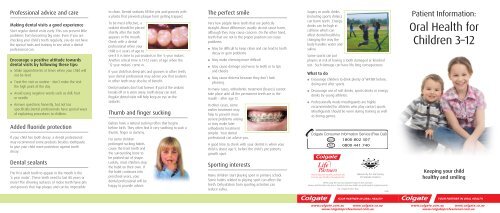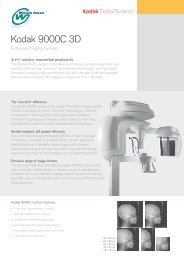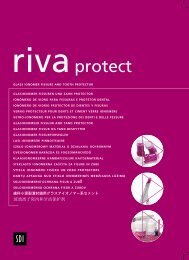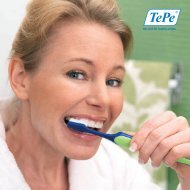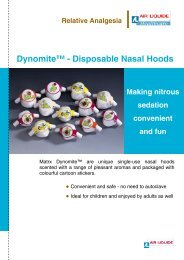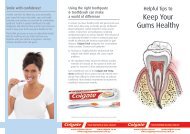Download the Oral Health for Children 3-12 Brochure
Download the Oral Health for Children 3-12 Brochure
Download the Oral Health for Children 3-12 Brochure
You also want an ePaper? Increase the reach of your titles
YUMPU automatically turns print PDFs into web optimized ePapers that Google loves.
Professional advice and care<br />
Making dental visits a good experience<br />
Start regular dental visits early. This can prevent little<br />
problems from becoming big ones. Even if you are<br />
checking your child’s teeth regularly, you do not have<br />
<strong>the</strong> special tools and training to see what a dental<br />
professional can.<br />
Encourage a positive attitude towards<br />
dental visits by following <strong>the</strong>se tips:<br />
l Make appointments at times when your child will<br />
not be tired<br />
l Treat <strong>the</strong> visit as routine – don’t make <strong>the</strong> visit<br />
<strong>the</strong> high point of <strong>the</strong> day<br />
l Avoid using negative words such as drill, hurt<br />
or needle<br />
l Answer questions honestly, but not too<br />
specifically.Dental professionals have special ways<br />
of explaining procedures to children.<br />
Added fluoride protection<br />
If your child has tooth decay, a dental professional<br />
may recommend some products besides toothpaste<br />
to give your child more protection against tooth<br />
decay.<br />
Dental sealants<br />
The first adult tooth to appear in <strong>the</strong> mouth is <strong>the</strong><br />
‘6 year molar’. These teeth need to last 80 years or<br />
more! The chewing surfaces of molar teeth have pits<br />
and grooves that trap plaque and can be impossible<br />
to clean. Dental sealants fill <strong>the</strong> pits and grooves with<br />
a plastic that prevents plaque from getting trapped.<br />
To be most effective, a<br />
sealant should be placed<br />
shortly after <strong>the</strong> tooth<br />
appears in <strong>the</strong> mouth.<br />
Check with a dental<br />
professional when your<br />
child is 6 years of age to<br />
see if it is time to put sealants in <strong>the</strong> ‘6 year molars’.<br />
Ano<strong>the</strong>r critical time is 11–<strong>12</strong> years of age when <strong>the</strong><br />
‘<strong>12</strong> year molars’ come in.<br />
If your child has deep pits and grooves in o<strong>the</strong>r teeth,<br />
your dental professional may advise you that sealants<br />
in o<strong>the</strong>r teeth may also be of benefit.<br />
Dental sealants don’t last <strong>for</strong>ever. If part of <strong>the</strong> sealant<br />
breaks off or is worn away, tooth decay can start.<br />
Regular dental visits will help keep an eye on <strong>the</strong><br />
sealants.<br />
Thumb and finger sucking<br />
Babies have a natural sucking reflex that begins<br />
be<strong>for</strong>e birth. They often find it very soothing to suck a<br />
thumb, finger or dummy.<br />
For some children<br />
prolonged sucking habits<br />
cause <strong>the</strong> front teeth and<br />
<strong>the</strong> surrounding bone to<br />
be pushed out of shape.<br />
Luckily, most children stop<br />
<strong>the</strong> habit on <strong>the</strong>ir own. If<br />
<strong>the</strong> habit continues into<br />
preschool years, your<br />
dental professional will be<br />
happy to provide advice.<br />
The perfect smile<br />
Very few people have teeth that are perfectly<br />
straight. Minor differences usually do not cause harm,<br />
although <strong>the</strong>y may cause concern. On <strong>the</strong> o<strong>the</strong>r hand,<br />
teeth that are not in <strong>the</strong> proper position can cause<br />
problems:<br />
l May be difficult to keep clean and can lead to tooth<br />
decay or gum problems<br />
l May make chewing more difficult<br />
l May cause damage and wear to teeth or to lips<br />
and cheeks<br />
l May cause distress because <strong>the</strong>y don’t look<br />
pleasing.<br />
In many cases, orthodontic treatment (braces) cannot<br />
take place until all <strong>the</strong> permanent teeth are in <strong>the</strong><br />
mouth – after age <strong>12</strong>.<br />
In o<strong>the</strong>r cases, some<br />
earlier treatment may<br />
help to prevent more<br />
severe problems arising<br />
or may make later<br />
orthodontic treatment<br />
simpler. Your dental<br />
professional can advise you.<br />
A good time to check with your dentist is when your<br />
child is about age 9, be<strong>for</strong>e <strong>the</strong> child’s pre-puberty<br />
growth spurt.<br />
Sporting interests<br />
Many children start playing sport in primary school.<br />
Some habits related to playing sport can affect <strong>the</strong><br />
teeth. Dehydration from sporting activities can<br />
reduce saliva.<br />
Sugary or acidic drinks<br />
(including sports drinks)<br />
can harm teeth. Energy<br />
drinks can be high in<br />
caffeine which can<br />
affect dental health by<br />
changing <strong>the</strong> way <strong>the</strong><br />
body handles water and<br />
saliva.<br />
Some sports can put<br />
players at risk of having a tooth damaged or knocked<br />
out. Such damage can have life long consequences.<br />
What to do<br />
l Encourage children to drink plenty of WATER be<strong>for</strong>e,<br />
during and after sports.<br />
l Discourage use of soft drinks, sports drinks or energy<br />
drinks by young athletes.<br />
l Professionally made mouthguards are highly<br />
recommended <strong>for</strong> athletes who play contact sports.<br />
Mouthguards should be worn during training as well<br />
as during games.<br />
Partnering with health professionals<br />
to keep you healthy throughout life.<br />
When using <strong>the</strong> oral care products found in this brochure:<br />
Always read <strong>the</strong> label l Use only as directed l See your health care professional if symptoms persist<br />
TM “Colgate Smiles” Reg<br />
Endorsed by <strong>the</strong> ANZ Society<br />
of Paediatric Dentistry<br />
0410<br />
Patient In<strong>for</strong>mation:<br />
<strong>Oral</strong> <strong>Health</strong> <strong>for</strong><br />
<strong>Children</strong> 3–<strong>12</strong><br />
Keeping your child<br />
healthy and smiling
Only two sets of teeth<br />
to last a lifetime!<br />
By 3 years of age, your child will<br />
have all 20 primary (baby) teeth.<br />
The primary teeth are important<br />
<strong>for</strong> many reasons and need to<br />
be taken care of until <strong>the</strong> adult<br />
teeth replace <strong>the</strong>m. Decay in <strong>the</strong><br />
primary teeth can mean your child<br />
may tend to develop decay in <strong>the</strong><br />
permanent (adult) teeth.<br />
From about 6–<strong>12</strong> years of age your child will lose all <strong>the</strong><br />
baby teeth as <strong>the</strong> permanent teeth emerge.<br />
These permanent<br />
teeth need to<br />
last 70–80 years!<br />
With a little daily<br />
attention to oral<br />
care and diet<br />
from an early<br />
age, your child<br />
can have<br />
healthy teeth<br />
<strong>for</strong> a lifetime.<br />
<strong>Oral</strong> care at home<br />
Starting from 6 years of age baby teeth<br />
are replaced with adult teeth<br />
What your child does at home everyday is essential<br />
to staying healthy! <strong>Children</strong> learn how to take care of<br />
<strong>the</strong>mselves from parents, siblings and carers. <strong>Children</strong><br />
learn so much just by imitating those around <strong>the</strong>m.<br />
Tooth brushing<br />
Plaque is <strong>the</strong> sticky, soft<br />
layer of bacteria that<br />
<strong>for</strong>ms on teeth everyday.<br />
Plaque needs to be<br />
removed each day to<br />
prevent tooth decay and<br />
gum problems. Studies<br />
show that brushing twice<br />
a day reduces <strong>the</strong> risk of<br />
tooth decay much more<br />
than just brushing once<br />
a day. Brushing be<strong>for</strong>e<br />
bedtime is especially<br />
important.<br />
<strong>Children</strong> should be encouraged to brush <strong>the</strong>ir own<br />
teeth. However, children do not have <strong>the</strong> coordination<br />
needed to use a toothbrush properly until <strong>the</strong>y are<br />
about 8 or 9. For this reason, parents or carers need to<br />
assist with thorough brushing at least once a day.<br />
Toothpaste<br />
Fluoride protection against<br />
tooth decay is needed throughout life. Using fluoride<br />
toothpaste twice a day is one of <strong>the</strong> most proven ways<br />
<strong>for</strong> you and your children to stay decay-free. Fluoride<br />
in toothpaste makes teeth more resistant to <strong>the</strong> acids<br />
produced after eating or drinking. Fluoride also puts<br />
back minerals that are lost from teeth and can reverse<br />
<strong>the</strong> early stages of tooth decay.<br />
Because children under <strong>the</strong> age of 6 tend to swallow<br />
ra<strong>the</strong>r than spit out excess<br />
toothpaste, <strong>the</strong>y need to use<br />
low fluoride toothpaste, such as<br />
Colgate ® Sparkling Mint Gel 2–6.<br />
Colgate Sparkling Mint Gel 2–6 toothpaste was<br />
developed with leading dental professionals <strong>for</strong><br />
use in children under <strong>the</strong> age of 6.<br />
After age 6, children should use a toothpaste<br />
with more fluoride, such as Colgate ® Sparkling<br />
Mint Gel 6+.<br />
Only a pea-sized<br />
amount of paste<br />
is needed. All toothpaste<br />
needs to be stored out of<br />
<strong>the</strong> reach of children.<br />
When do permanent<br />
teeth erupt?<br />
Flossing<br />
Dental floss is used<br />
to remove plaque<br />
between teeth where a<br />
toothbrush can’t reach.<br />
Parents and carers<br />
should start flossing<br />
children’s teeth when<br />
<strong>the</strong> teeth start fitting close toge<strong>the</strong>r.<br />
It is a good idea to get some coaching from a dental<br />
professional. It isn’t easy to floss someone else’s<br />
teeth! By <strong>the</strong> age of 13 children should be able to floss<br />
without help or supervision.<br />
Have a look<br />
Plaque is not easy to<br />
see unless <strong>the</strong>re is lots<br />
of it. Plaque disclosing<br />
tablets contain a food<br />
dye that stains plaque<br />
so it is easier to see.<br />
Use plaque disclosing<br />
tablets occasionally<br />
to help you and your child<br />
see places missed with<br />
<strong>the</strong> toothbrush and floss.<br />
Disclosing tablets can be<br />
purchased at pharmacies.<br />
Parents are encouraged to look in <strong>the</strong>ir children’s<br />
mouths regularly. Gently ‘lift <strong>the</strong> lip’ and look <strong>for</strong><br />
white spots at <strong>the</strong> gumline, particularly on <strong>the</strong> upper<br />
teeth. The white spots may be an early sign of tooth<br />
decay. Seek professional advice if you see white spots<br />
at <strong>the</strong> gumline in your child’s mouth.<br />
Tooth friendly diet<br />
Eating patterns are just as important as <strong>the</strong> types<br />
of foods and drinks children have. The risk of<br />
tooth decay can increase if children eat too often<br />
throughout <strong>the</strong> day.<br />
Saliva is <strong>the</strong> body’s<br />
natural defence against<br />
tooth decay – constantly<br />
replacing <strong>the</strong> minerals<br />
in teeth and washing<br />
away acids. To give saliva<br />
enough time to work,<br />
limit <strong>the</strong> number of times<br />
your child eats throughout<br />
<strong>the</strong> day.<br />
A general rule of thumb is<br />
to limit eating times to 3<br />
meals and 2 snacks each day.<br />
‘Tooth friendly’ food and drink tips:<br />
l Encourage healthy snacks such as dairy products,<br />
unsalted popcorn, fruits and vegetables in place of<br />
sugary snacks<br />
l Keep healthy snacks readily available <strong>for</strong> children<br />
to grab<br />
l Limit intake of acidic drinks such as soft drinks<br />
(diet and regular), sports drinks, fruit juices, fruit<br />
drinks, cordials – don’t sip on <strong>the</strong>m too long and<br />
limit how often you have <strong>the</strong>m<br />
l Drink water! (Note: not all bottled water has<br />
fluoride to help prevent tooth decay).


